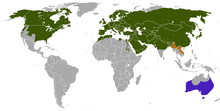
Back ቀይ ቀበሮ Amharic Vulpes vulpes AN Fox ANG ثعلب أحمر Arabic ثعلب احمر ARZ Vulpes vulpes AST Цер AV Bresitol (Vulpes vulpes) AVK Adi tülkü Azerbaijani عادی تۆلکو AZB
| Red fox Temporal range: Middle Pleistocene – present
| |
|---|---|

| |
| Scientific classification | |
| Domain: | Eukaryota |
| Kingdom: | Animalia |
| Phylum: | Chordata |
| Class: | Mammalia |
| Order: | Carnivora |
| Family: | Canidae |
| Genus: | Vulpes |
| Species: | V. vulpes
|
| Binomial name | |
| Vulpes vulpes | |
| Subspecies | |

| |
| Distribution of the red fox native
introduced presence uncertain | |
| Synonyms | |
| |
The red fox (Vulpes vulpes) is the largest of the true foxes and one of the most widely distributed members of the order Carnivora, being present across the entire Northern Hemisphere including most of North America, Europe and Asia, plus parts of North Africa. It is listed as least concern on the IUCN Red List.[1] Its range has increased alongside human expansion, having been introduced to Australia, where it is considered harmful to native mammals and bird populations. Due to its presence in Australia, it is included on the list of the "world's 100 worst invasive species".[4]
The red fox originated from smaller-sized ancestors from Eurasia during the Middle Villafranchian period,[5] and colonised North America shortly after the Wisconsin glaciation.[6] Among the true foxes, the red fox represents a more progressive form in the direction of carnivory.[7] Apart from its large size, the red fox is distinguished from other fox species by its ability to adapt quickly to new environments. Despite its name, the species often produces individuals with other colourings, including leucistic and melanistic individuals.[7] Forty-five subspecies are currently recognised,[8] which are divided into two categories: the large northern foxes and the small, basal southern grey desert foxes of Asia and North Africa.[7]
Red foxes are usually found in pairs or small groups consisting of families, such as a mated pair and their young, or a male with several females having kinship ties. The young of the mated pair remain with their parents to assist in caring for new kits.[9] The species primarily feeds on small rodents, though it may also target rabbits, squirrels, game birds, reptiles, invertebrates[7] and young ungulates.[7] Fruit and vegetable matter is also eaten sometimes.[10] Although the red fox tends to kill smaller predators, including other fox species, it is vulnerable to attack from larger predators, such as wolves, coyotes, golden jackals, large predatory birds such as golden eagles and Eurasian eagle owls,[11] and medium- and large-sized felids.[12]
The species has a long history of association with humans, having been extensively hunted as a pest and furbearer for many centuries, as well as being represented in human folklore and mythology. Because of its widespread distribution and large population, the red fox is one of the most important furbearing animals harvested for the fur trade.[13]: 229–230 Too small to pose a threat to humans, it has extensively benefited from the presence of human habitation, and has successfully colonised many suburban and urban areas. Domestication of the red fox is also underway in Russia, and has resulted in the domesticated silver fox.
- ^ a b Hoffmann, M. & Sillero-Zubiri, C. (2021) [amended version of 2016 assessment]. "Vulpes vulpes". IUCN Red List of Threatened Species. 2021: e.T23062A193903628. doi:10.2305/IUCN.UK.2021-1.RLTS.T23062A193903628.en. Retrieved 17 February 2022.
- ^ "Vulpes vulpes". NatureServe Explorer. Retrieved 17 April 2024.
- ^ Linnaeus, Carl (1758). "Canis Vulpes". Caroli Linnæi Systema naturæ per regna tria naturæ, secundum classes, ordines, genera, species, cum characteribus, differentiis, synonymis, locis (in Latin). Vol. Tomus I (decima, reformata ed.). Holmiae: Laurentius Salvius. p. 40.
- ^ "100 of the World's Worst Invasive Alien Species". Invasive Species Specialist Group. Archived from the original on 16 March 2017. Retrieved 17 March 2011.
- ^ Cite error: The named reference
k115was invoked but never defined (see the help page). - ^ Kurtén, B. & Anderson, E. (1980). Pleistocene Mammals of North America. Columbia University Press. pp. 96, 174. ISBN 9780231037334.
- ^ a b c d e Heptner, V. G.; Naumov, N. P. (1998). Mammals of the Soviet Union. Leiden: Brill. pp. 115, 341–365, 453–502, 513–562. ISBN 978-1886106819.
- ^ Cite error: The named reference
msw3was invoked but never defined (see the help page). - ^ Harris, S. & Yalden, D. (2008). Mammals of the British Isles: Handbook (Fourth ed.). Southampton: Mammal Society. pp. 408–422. ISBN 978-0906282656.
- ^ Feldhamer, G.; Thompson, B. & Chapman, J. (2003). Wild Mammals of North America: Biology, Management, and Conservation: Biology, Management and Economics (Second ed.). Johns Hopkins University Press. pp. 516–530. ISBN 9780801874161.
- ^ "Red Fox Predators". Wildlife Online. Archived from the original on 10 June 2022. Retrieved 27 May 2021.
- ^ Fedriani, J. M.; Palomares, F. & Delibes, M. (1999). "Niche relations among three sympatric Mediterranean carnivores". Oecologia. 121 (1): 138–148. Bibcode:1999Oecol.121..138F. CiteSeerX 10.1.1.587.7215. doi:10.1007/s004420050915. JSTOR 4222449. PMID 28307883. S2CID 39202154.
- ^ Bachrach, M. (1953). Fur: A Practical Treatise (Third ed.). New York: Prentice-Hall.
© MMXXIII Rich X Search. We shall prevail. All rights reserved. Rich X Search

